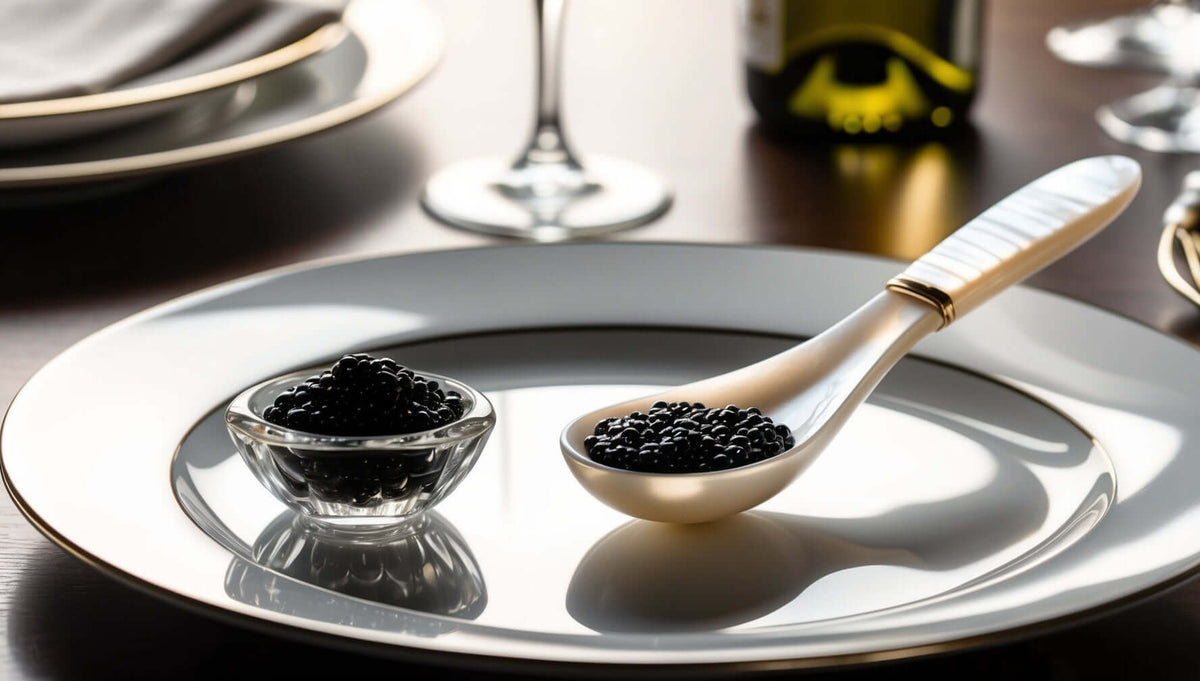
The Essential Guide to Caviar Spoons: Tradition, Science, and Elegance
|
|
Time to read 4 min
|
|
Time to read 4 min
The humble caviar spoon is a powerful tool in the world of luxury dining, designed not just for functionality but also to preserve the delicate flavor of one of the most prized delicacies—caviar. While its elegant appearance adds to the luxury experience, the caviar spoon’s true importance lies in its ability to maintain the integrity of the roe. This article explores the history, science, etiquette, and modern innovations surrounding caviar spoons, answering common questions while optimizing your knowledge of this essential dining accessory.
Caviar enthusiasts are often warned against using metal spoons, particularly those made of silver or stainless steel. The reason is rooted in chemistry: metal can oxidize when it comes into contact with the roe, leaving behind an unpleasant metallic taste that overpowers the caviar’s subtle, briny flavor.
This is why non-metallic materials—such as mother-of-pearl, wood, or plastic—are preferred for serving caviar. These materials are chemically inert, ensuring that the delicate roe retains its natural essence.
Mother-of-pearl spoons are synonymous with caviar service for several reasons:
Non-Reactive Material
Mother-of-pearl is non-reactive, meaning it won’t chemically interact with caviar to alter its taste or aroma.
Elegance and Tradition
The shimmering iridescence of mother-of-pearl adds an element of sophistication to caviar service, complementing the luxury of the roe.
Durability and Smoothness
Mother-of-pearl spoons are smooth and durable, making them ideal for scooping the delicate eggs without breaking them.
The use of specialized utensils for caviar dates back centuries, particularly in the royal courts of Russia and Persia. In these settings, caviar was not only a culinary delicacy but also a symbol of status. Early spoons were often made from ivory or bone, chosen for their non-reactive properties.
By the 19th century, mother-of-pearl became the material of choice among European elites, cementing its place as the preferred medium for caviar spoons. Today, mother-of-pearl remains a hallmark of elegance, its timeless appeal unmatched by modern alternatives.
Material Advantages Disadvantages
| Mother-of-Pearl | Non-reactive, elegant, durable, traditional | Expensive |
| Wood | Affordable, non-reactive, natural | Less elegant, can absorb flavors |
| Plastic | Inexpensive, non-reactive, widely available | Lacks luxury appeal |
| Silver/Stainless Steel | Durable, widely available | Can impart a metallic taste, not ideal for caviar |
While mother-of-pearl remains the gold standard, modern dining trends have introduced new materials and designs. Biodegradable plastics cater to eco-conscious consumers, while stainless steel spoons are sometimes used in casual settings. However, these alternatives rarely match the elegance and functionality of traditional mother-of-pearl.
Using a caviar spoon isn’t just about functionality—it’s a nod to tradition and respect for the delicacy. Here are some tips to elevate your dining experience:
Metal spoons can oxidize upon contact with caviar, imparting a metallic taste that disrupts the roe’s delicate flavor.
Caviar spoons are typically crafted from non-reactive materials such as mother-of-pearl, wood, or plastic to preserve the roe’s flavor.
Yes, plastic spoons are a practical alternative for serving caviar. However, they lack the elegance and tradition associated with mother-of-pearl spoons.
The price of a spoonful of caviar varies based on the type and quality of the roe. Premium varieties like Beluga or Ossetra can range from $20 to $100 per spoonful.
Pearl spoons are non-reactive and aesthetically pleasing, making them ideal for preserving the flavor and enhancing the presentation of caviar.
When it comes to enjoying caviar, the choice of spoon is more than a matter of aesthetics—it’s a critical element of the experience. The caviar spoon you select directly influences the delicate flavors of the roe.
Mother-of-pearl spoons , revered for their non-reactive properties, ensure that the taste remains unaltered, letting the pure briny essence of the caviar shine through. But what makes mother-of-pearl so special? Unlike metals, which can oxidize and impart a metallic taste, mother-of-pearl is smooth, elegant, and naturally inert, making it the gold standard for luxury dining.
Beyond mother-of-pearl, modern caviar enthusiasts are exploring alternatives like wood and biodegradable plastic spoons for casual or eco-conscious settings. While these options offer practicality, they rarely match the timeless sophistication of traditional materials.
For the most authentic experience, always reach for a non-metallic spoon —a simple choice that elevates the enjoyment of this prized delicacy. After all, the right spoon transforms caviar from a meal into an indulgent ritual.
The caviar spoon is more than a dining tool—it’s an emblem of sophistication and tradition. Whether you’re hosting a luxurious dinner or indulging in a quiet moment of self-care, the right caviar spoon elevates the experience from ordinary to extraordinary. Its materials, history, and etiquette all contribute to the timeless ritual of enjoying caviar as it was meant to be savored.
For more on caviar spoons, including purchasing options and care tips, visit Opus Caviar.
Caviar Chronicles
$0.00 USD






